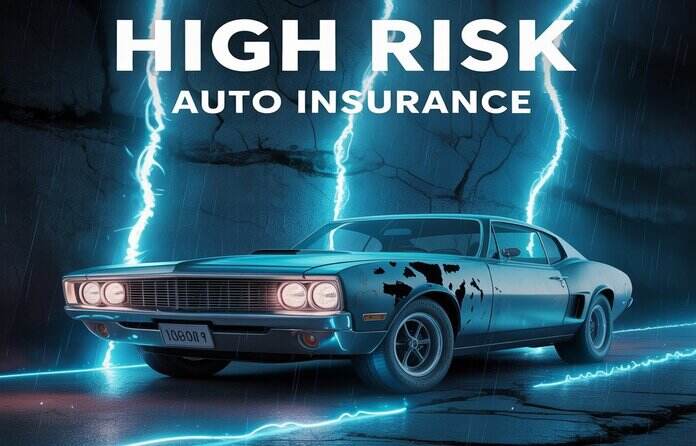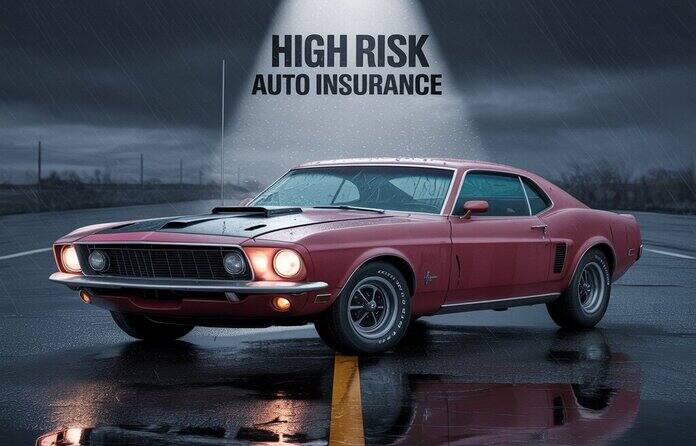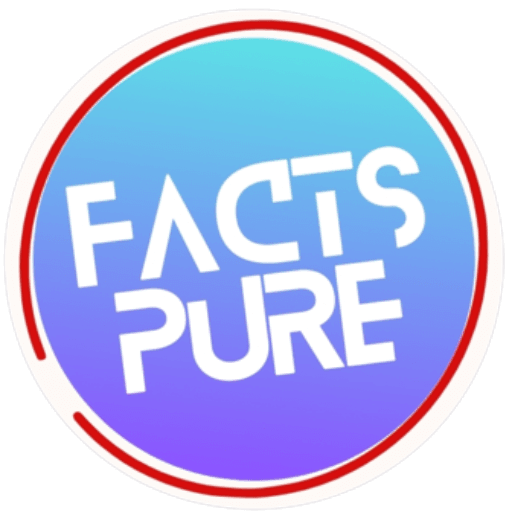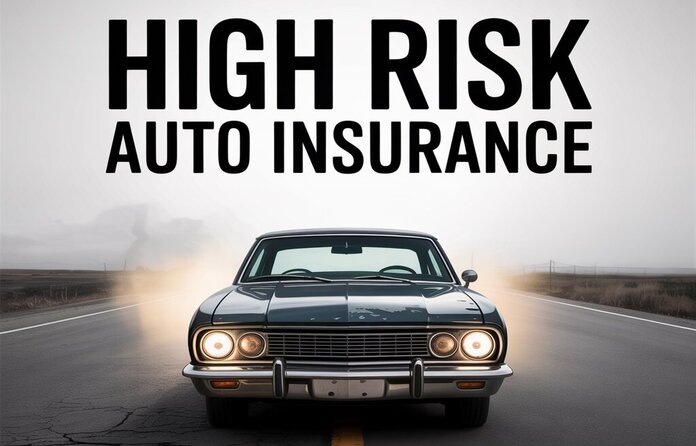High Risk Auto Insurance Canada: Complete Guide to Finding Affordable Coverage (2025)
High risk auto insurance in Canada typically costs 30-300% more than standard rates, with average premiums ranging from $2,500 to $8,000+ annually. Drivers classified as high risk can find coverage through specialized providers like Facility Association, Pafco, and Jevco, which offer policies specifically designed for those with multiple tickets, accidents, DUIs, or insurance gaps.
Are you battling to discover reasonable car protections due to your driving history? You’re not alone – thousands of Canadians face this challenge every day. This guide provides everything you need to know about high risk auto insurance in Canada.
Read More: Car Insurance Ontario High Risk
What Makes You a High Risk Driver in Canada?
Insurance companies classify drivers as “high risk” when their history indicates a greater likelihood of filing claims. Understanding what puts you in this category is the first step toward improving your situation.
Driving Violations That Trigger High Risk Status
Your driving record is the primary factor insurers consider when assessing risk. These violations significantly impact your insurance rates:
- Major traffic violations: DUIs/DWIs can increase premiums by 100-300%
- Multiple tickets: Three or more tickets within three years typically triggers high risk status
- At-fault accidents: Two or more at-fault claims in a three-year period
- Stunt driving or excessive speeding: Premiums can double with a single serious speeding conviction
- License suspensions: Any suspension history raises red flags for insurers
Non-Driving Factors That Affect Risk Classification
Beyond your driving record, insurers consider these additional factors:
- Insurance payment history: Multiple late payments or policy cancellations
- Coverage gaps: Periods without continuous insurance coverage
- Insurance fraud: Any history of fraudulent claims
- Vehicle type: High-performance or frequently stolen models
- Age and experience: New drivers and those under 25 or over 80
Most Canadian drivers find themselves in the high risk category due to a combination of these factors rather than a single incident.
How Much Does High Risk Auto Insurance Cost in Canada?
The price difference between standard and high risk insurance is substantial, but costs vary widely based on several factors. Here’s what you can anticipate to pay in 2025:

Average Premium Ranges by Risk Level
| Risk Category | Annual Premium Range | Monthly Cost |
| Standard Risk | $1,300 – $1,800 | $108 – $150 |
| Moderate Risk | $2,000 – $3,500 | $167 – $292 |
| High Risk | $3,000 – $6,000 | $250 – $500 |
| Severe Risk | $5,000 – $10,000+ | $417 – $833+ |
Cost Breakdown by Province
Insurance rates change altogether over Canada due to common regulations:
- Ontario: Highest rates, averaging $4,500 – $9,000 for high risk drivers
- British Columbia: Recently privatized, with high risk premiums around $3,500 – $7,000
- Alberta: Moderate rates, typically $3,000 – $6,500
- Quebec: Often the lowest, with high risk premiums from $2,500 – $5,000
- Atlantic Provinces: Varied rates, generally $3,000 – $6,000
Additional Cost Factors to Consider
The last cost of your arrangement depends on these variables:
- Coverage limits: Minimum liability coverage (typically $200,000) vs. recommended ($2 million)
- Deductible amount: Higher deductibles lower premiums but increase out-of-pocket costs
- Vehicle type: Luxury or sports cars cost significantly more to insure
- Urban vs. rural location: Urban drivers typically pay 15-40% more
Which Companies Offer High Risk Auto Insurance in Canada?
Not all insurance providers are willing to take on high risk drivers, but several specialize in this market segment. Here are your best options in 2025:
Specialized High Risk Insurance Providers
These companies focus specifically on difficult-to-insure drivers:
- Facility Association: Last-resort option available in all provinces except BC, Manitoba, and Saskatchewan
- Pafco Insurance: Specializes in high risk drivers, competitive rates for those with multiple tickets
- Jevco Insurance: Known for covering drivers with DUI convictions
- Coachman Insurance: Strong option for those with several at-fault accidents
- Echelon Insurance: Offers flexible payment options for high risk policies
Traditional Insurers with High Risk Divisions
Some mainstream companies have separate divisions for non-standard policies:
- Intact Insurance (through Intact Prestige): Best for borderline high risk cases
- TD Insurance (through TD Insurance Meloche Monnex): Competitive for high risk drivers with clean records in recent years
- Aviva Canada (through Traders General): Offers gradual rate improvements for good behavior
Broker Networks Specializing in High Risk Cases
Working with a broker can save time and money when shopping for high risk coverage:
- Sharp Insurance: Specializes in high risk cases across multiple provinces
- Mitchell & Whale Insurance Brokers: Known for finding competitive rates for complex cases
- Kanetix: Comparison service to find the best available rates.

How to Lower Your High Risk Auto Insurance Premiums
While high risk status inevitably means higher premiums, several strategies can help reduce your costs:
Immediate Actions to Reduce Premiums
These steps can provide immediate savings on your insurance costs:
- Bundle approaches: Combining domestic and auto can spare 10-25%
- Increase deductibles: Raising from $500 to $1,000 typically saves 5-10%
- Install anti-theft devices: Can reduce premiums by 5-15%
- Take a defensive driving course: Savings of 5-15% with many insurers
- Pay annually instead of monthly: Eliminates administrative fees of 3-5%
- Limit your mileage: Usage-based insurance can save up to 25% for low-mileage drivers
Long-Term Strategies to Improve Your Risk Profile
These approaches require time but lead to substantial savings:
- Maintain a clean driving record: Each year without incidents typically lowers premiums by 5-10%
- Improve your credit score: In provinces where it’s considered, a better score can reduce rates by 10-25%
- Choose vehicles with lower insurance costs: Family sedans and minivans cost less to insure than sports cars
- Avoid coverage gaps: Even minimum coverage prevents the higher rates that come with insurance lapses
- Consider usage-based insurance: Programs that monitor driving habits can reward safe drivers with discounts up to 30%
The Step-Down Approach to Returning to Standard Insurance
Many drivers can gradually transition back to standard insurance rates:
- Year 1-2: Focus on building a clean record with a high risk insurer
- Year 3-4: Shop around as some violations may no longer affect your record
- Year 5+: Most drivers can return to standard market rates if they’ve maintained a clean record
How to Shop for High Risk Auto Insurance in Canada
Finding the best high risk coverage requires a strategic approach:
Essential Steps Before Requesting Quotes
Prepare properly to find the best possible rates:
- Review your driving record: Order your official driver’s abstract to know exactly what insurers will see
- Check your insurance history report: Request your AutoPlus report to review past claims
- Prepare vehicle data: VIN number, make, demonstrate, year, and security features
- Determine coverage needs: Balance minimum requirements with adequate protection
- Set realistic budget expectations: Research typical rates for your risk level
How to Work Effectively with Brokers
Insurance brokers can be valuable allies for high risk drivers:
- Be completely honest about your driving history
- Ask specifically about high risk specialists
- Request cites from at slightest 3-5 diverse companies
- Inquire about discount opportunities
- Discuss step-down programs for future rate improvements
Red Flags to Watch For When Shopping for High Risk Insurance
Protect yourself by avoiding these common pitfalls:
- Suspiciously low premiums (likely missing coverage)
- Brokers unwilling to explain policy exclusions
- Pressure to make immediate decisions
- Hidden fees or unusual payment requirements
- Companies not registered with your provincial insurance regulator

Frequently Asked Questions About High Risk Auto Insurance in Canada
How long will I be considered a high risk driver?
Most violations affect your insurance rates for 3-6 years, depending on severity. DUIs can impact rates for up to 10 years in some provinces. Maintaining a clean record during this period gradually improves your risk classification.
Can I be denied auto insurance completely in Canada?
No, all drivers can get coverage through Facility Association in most provinces, or government insurance in BC, Manitoba, and Saskatchewan. However, premiums may be extremely high for the highest risk drivers.
Does high risk insurance cover the same things as standard insurance?
Basic coverage requirements remain the same, but high risk policies often have additional exclusions or limitations. Always review policy details carefully to understand exactly what is and isn’t covered.
Can I switch companies while classified as high risk?
Yes, you can switch providers even with a high risk classification. Compare quotes carefully as rates can vary significantly between companies that specialize in different types of high risk drivers.
Will moving to a different province help lower my high risk status?
Generally no, as your driving record follows you across provincial lines. Some provinces may have slightly different rating systems, but major violations will impact your rates throughout Canada.
How do I know if I’m being charged fair rates as a high risk driver?
Compare quotes from at least 3-5 specialized high risk providers. Rate differences exceeding 20% between quotes suggest you should continue shopping for better options.
Conclusion: Finding Your Path Through High Risk Auto Insurance
Navigating high risk auto insurance in Canada is challenging but manageable with the right approach. While premiums ranging from $2,500 to $8,000+ annually represent a significant expense, understanding your options allows you to find the most affordable coverage possible.
Remember that high risk status is temporary for most drivers. Each year of safe driving brings you closer to standard insurance rates. Focus on maintaining a clean record, exploring all available discounts, and working with insurers that specialize in helping drivers like you.
The most important step is to maintain continuous coverage, even if premiums are higher than you’d like. Letting your insurance lapse only makes your situation worse and more expensive in the long run.
Reference Link: progressive
Ready to find the best possible rate for your situation? Start by gathering quotes from the specialized high risk providers listed above, and consider working with a broker experienced in non-standard auto insurance. With persistence and careful shopping, you can find coverage that protects you adequately without breaking your budget.


